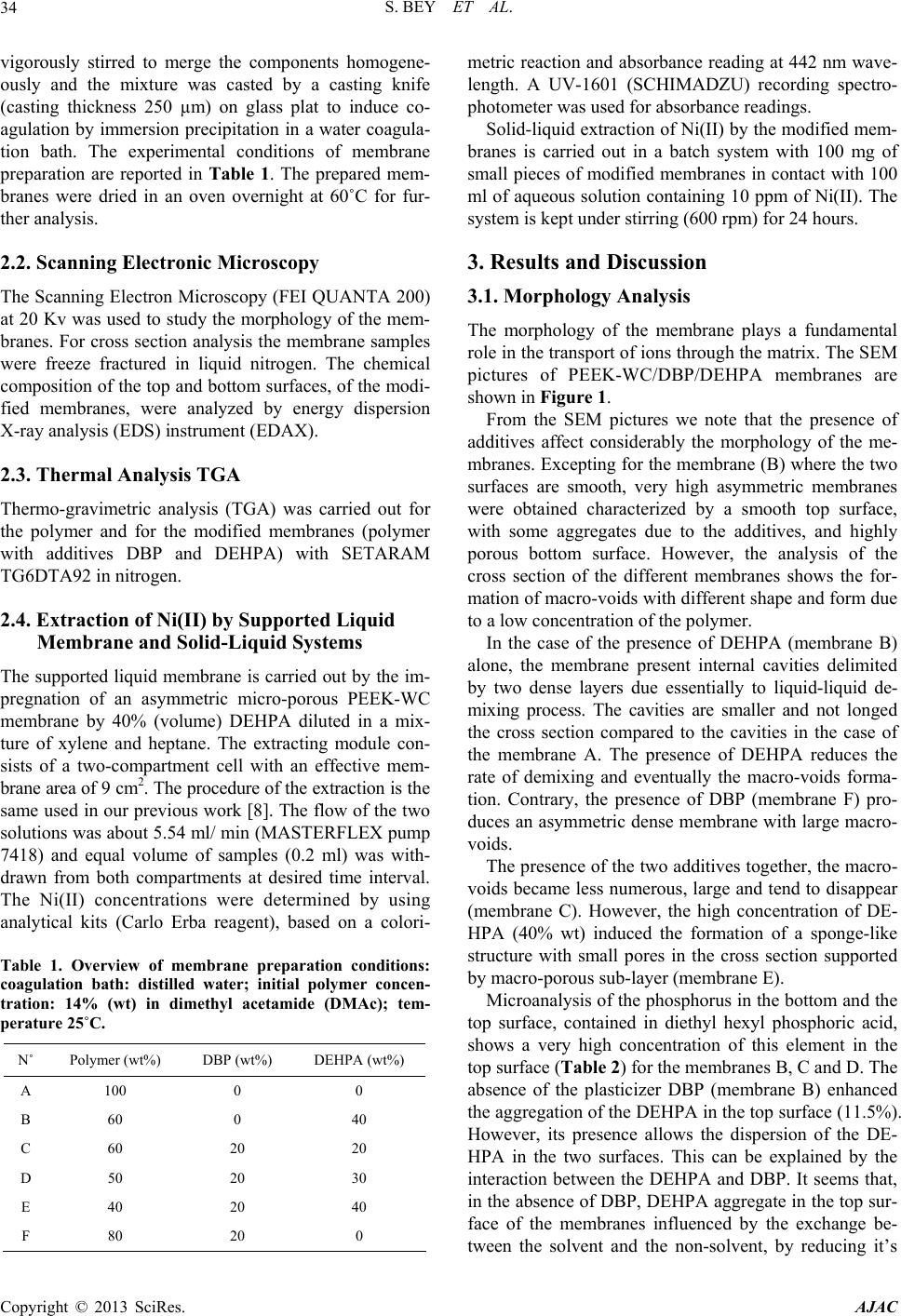
S. BEY ET AL.
34
vigorously stirred to merge the components homogene-
ously and the mixture was casted by a casting knife
(casting thickness 250 µm) on glass plat to induce co-
agulation by immersion precipitation in a water coagula-
tion bath. The experimental conditions of membrane
preparation are reported in Table 1. The prepared mem-
branes were dried in an oven overnight at 60˚C for fur-
ther analysis.
2.2. Scanning Electronic Microscopy
The Scanning Electron Microscopy (FEI QUANTA 200)
at 20 Kv was used to study the morphology of the mem-
branes. For cross section analysis the membrane samples
were freeze fractured in liquid nitrogen. The chemical
composition of the top and bottom surfaces, of the modi-
fied membranes, were analyzed by energy dispersion
X-ray analysis (EDS) instrument (EDAX).
2.3. Thermal Analysis TGA
Thermo-gravimetric analysis (TGA) was carried out for
the polymer and for the modified membranes (polymer
with additives DBP and DEHPA) with SETARAM
TG6DTA92 in nitrogen.
2.4. Extraction of Ni(II) by Supported Liquid
Membrane and Solid-Liquid Systems
The supported liquid membrane is carried out by the im-
pregnation of an asymmetric micro-porous PEEK-WC
membrane by 40% (volume) DEHPA diluted in a mix-
ture of xylene and heptane. The extracting module con-
sists of a two-compartment cell with an effective mem-
brane area of 9 cm2. The procedure of the extraction is th e
same used in our previous work [8]. The flow of the two
solutions was about 5.54 ml/ min (MASTERFLEX pump
7418) and equal volume of samples (0.2 ml) was with-
drawn from both compartments at desired time interval.
The Ni(II) concentrations were determined by using
analytical kits (Carlo Erba reagent), based on a colori-
Table 1. Overview of membrane preparation conditions:
coagulation bath: distilled water; initial polymer concen-
tration: 14% (wt) in dimethyl acetamide (DMAc); tem-
perature 25˚C.
N˚ Polymer (wt%) DBP (wt%) DEHPA (wt%)
A 100 0 0
B 60 0 40
C 60 20 20
D 50 20 30
E 40 20 40
F 80 20 0
metric reaction and absorbance reading at 442 nm wave-
length. A UV-1601 (SCHIMADZU) recording spectro-
photometer was used for absorbance readings.
Solid-liquid extraction of Ni(II) by the modified mem-
branes is carried out in a batch system with 100 mg of
small pieces of modified membranes in contact with 100
ml of aqueous solution containing 10 ppm of Ni(II). The
system is kept under stirring (600 rpm) for 24 hours.
3. Results and Discussion
3.1. Morphology Analysis
The morphology of the membrane plays a fundamental
role in the transport of ions through the matrix. The SEM
pictures of PEEK-WC/DBP/DEHPA membranes are
shown in Figure 1.
From the SEM pictures we note that the presence of
additives affect considerably the morphology of the me-
mbranes. Excepting for the membrane (B) where the two
surfaces are smooth, very high asymmetric membranes
were obtained characterized by a smooth top surface,
with some aggregates due to the additives, and highly
porous bottom surface. However, the analysis of the
cross section of the different membranes shows the for-
mation of macro-voids with different shape and form due
to a low concentration of the polymer.
In the case of the presence of DEHPA (membrane B)
alone, the membrane present internal cavities delimited
by two dense layers due essentially to liquid-liquid de-
mixing process. The cavities are smaller and not longed
the cross section compared to the cavities in the case of
the membrane A. The presence of DEHPA reduces the
rate of demixing and eventually the macro-voids forma-
tion. Contrary, the presence of DBP (membrane F) pro-
duces an asymmetric dense membrane with large macro-
voids.
The presence of the two additiv es together, the macro-
voids became less numerous, large and tend to disappear
(membrane C). However, the high concentration of DE-
HPA (40% wt) induced the formation of a sponge-like
structure with small pores in the cross section supported
by macro-porous sub-layer (membrane E).
Microanalysis of the phosphorus in the bottom and the
top surface, contained in diethyl hexyl phosphoric acid,
shows a very high concentration of this element in the
top surface (Table 2) for the membranes B, C and D. The
absence of the plasticizer DBP (membrane B) enhanced
the aggregation of the DEHPA in the top surface (11.5%).
However, its presence allows the dispersion of the DE-
HPA in the two surfaces. This can be explained by the
interaction between the DEHPA and DBP. It seems that,
in the abs ence of DBP, DEHPA aggrega te in the top sur -
face of the membranes influenced by the exchange be-
tween the solvent and the non-solvent, by reducing it’s
Copyright © 2013 SciRes. AJAC